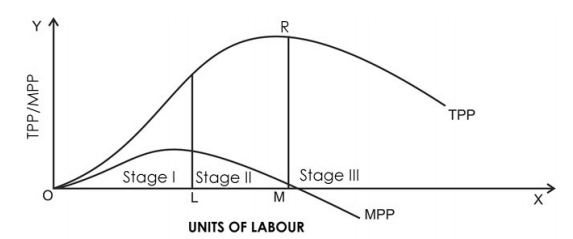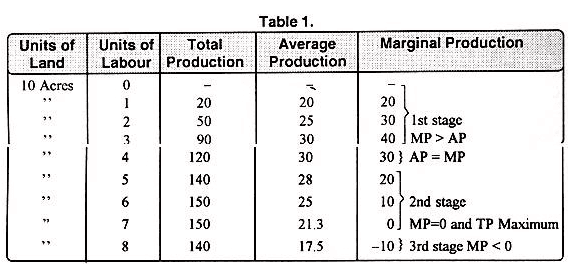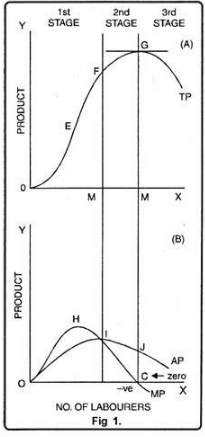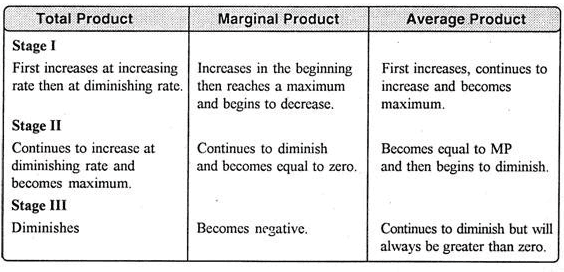Law of Variable Proportions | Crash Course for UGC NET Commerce PDF Download
| Table of contents |

|
| Law of Variable Proportions |

|
| Definitions |

|
| Graphic Presentation |

|
| Three Stages of the Law |

|
| In Which Stage Rational Decision is Possible |

|
Law of Variable Proportions

- Law of Variable Proportions is significant in economic theory and is also known as Law of Proportionality.
- This law clarifies how production functions when one factor changes while other factors stay the same.
- In the short term, when we want to increase the output of a product, this law comes into play.
- For example, let's consider two factors: land (fixed) and labor (variable).
- If we have 5 hectares of land and we grow wheat using labor, the ratio of land to labor is 1:5.
- When the number of laborers increases to 2, the new ratio becomes 2:5.
- Changing the ratio of factors affects the total output differently, which is the essence of the Law of Variable Proportion in production theory.
Definitions
Benham: As one factor is increased in a mix of factors, its additional output diminishes over a certain point.
- Samuelson: When some inputs increase compared to fixed inputs, output initially rises, but the additional output from extra inputs decreases progressively.
- Leftwitch: The law of variable proportion states that enhancing one resource while keeping others constant boosts total output, but beyond a threshold, the output growth slows down.
Law of Variable Proportions Assumptions:
- Constant Technology: The idea that technology stays the same. If technology gets better, production improves.
- Variable Factor Proportions: Assumes factors can change. If factors always combine in fixed amounts, the law doesn't work.
- Homogeneous Factor Units: Each unit of a factor is the same in quality and quantity.
- Short-Run: Refers to a specific time frame.
Explanation of the Law:
In order to understand the law of variable proportions we take the example of agriculture. Suppose land and labour are the only two factors of production.
- From table 1, we can see that the law of variable proportion has three stages.
- In the first stage, when more labor and capital are used with fixed land, average production increases initially. Total product, average product, and marginal product rise as well, but only up to 40 units.
- After this point, both average and marginal product start to decline because the ratio of workers to land becomes inefficient, resulting in underutilized land.
- The second stage begins where the first stage ends or when average product equals marginal product.
- In this stage, both average and marginal products decrease. However, the marginal product decreases faster than the average product. Total product continues to increase but at a slower rate.
- At 70 units of labor, total product peaks, with the marginal product hitting zero while the average product remains positive.
- The third stage commences after the second stage and starts at the 8th unit.
- Here, the marginal product is negative, leading to a decrease in total product. Despite this, the average product remains positive.
- Additional inputs in this stage result in diminishing returns, as extra doses lead to negative marginal product.
Graphic Presentation
In fig. 1, on OX axis, we have measured number of labourers while quantity of product is shown on OY axis. TP is total product curve. Up to point ‘E’, total product is increasing at increasing rate. Between points E and G it is increasing at the decreasing rate. Here marginal product has started falling. At point ‘G’ i.e., when 7 units of labourers are employed, total product is maximum while, marginal product is zero. Thereafter, it begins to diminish corresponding to negative marginal product. In the lower part of the figure MP is marginal product curve.

Up to point ‘H’ marginal product increases. At point ‘H’, i.e., when 3 units of labourers are employed, it is maximum. After that, marginal product begins to decrease. Before point ‘I’ marginal product becomes zero at point C and it turns negative. AP curve represents average product. Before point ‘I’, average product is less than marginal product. At point ‘I’ average product is maximum. Up to point T, average product increases but after that it starts to diminish.
Three Stages of the Law
- First Stage: Begins at point O and ends at point F. At point F, the average product is at its highest, equal to the marginal product. Initially, the total product rises rapidly until point E, then increases at a slower rate between E and F. The marginal product also rises initially, reaching its peak at point H, before decreasing and aligning with the average product at point T. During this stage, the marginal product surpasses the average product (MP > AP).
- Second Stage: Commences at point F. Here, the total product increases at a diminishing pace, peaking at point G. Simultaneously, the marginal product decreases rapidly, hitting zero at point C. The average product reaches its maximum at point I, then starts declining. In this stage, the marginal product is less than the average product (MP < AP).
Third Stage: Starts after point G. Total product begins to decrease, along with a decline in average product. The marginal product becomes negative, showcasing the Law of Diminishing Returns. In this phase, no company would continue production as the marginal product of labor turns negative, leading to losses for the employer when more labor units are employed. Given the three stages, a company aims to produce until a certain point in the second stage only.

In Which Stage Rational Decision is Possible
To make the things simple, let us suppose that, a is variable factor and b is the fixed factor. And a1, a2 , a3….are units of a and b1 b2b3…… are unit of b.
Stage I is characterized by increasing AP, so that the total product must also be increasing. This means that the efficiency of the variable factor of production is increasing i.e., output per unit of a is increasing. The efficiency of b, the fixed factor, is also increasing, since the total product with b1 is increasing.
The stage II is characterized by decreasing AP and a decreasing MP, but with MP not negative. Thus, the efficiency of the variable factor is falling, while the efficiency of b, the fixed factor, is increasing, since the TP with b1 continues to increase.
Finally, stage III is characterized by falling AP and MP, and further by negative MP. Thus, the efficiency of both the fixed and variable factor is decreasing.
|
237 videos|236 docs|166 tests
|
FAQs on Law of Variable Proportions - Crash Course for UGC NET Commerce
| 1. What is the Law of Variable Proportions? |  |
| 2. How is the Law of Variable Proportions represented graphically? |  |
| 3. What is the significance of the Law of Variable Proportions in economics? |  |
| 4. How does the Law of Variable Proportions affect the cost of production? |  |
| 5. Can the Law of Variable Proportions be applied to real-world production scenarios? |  |




















